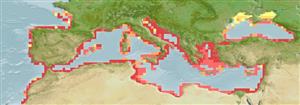Environment: milieu / climate zone / depth range / distribution range
Ecologie
marien; brak water demersaal; diepte 10 - ? m (Ref. 3573). Subtropical; 47°N - 29°N, 11°W - 42°E
Eastern Atlantic: Mediterranean Sea, the Black Sea, Sea of Azov and Atlantic coasts from Morocco to France. Introduced to Iran and is now naturally occurring in the Caspian Sea basin (Ref. 50218).
Lengte bij maturiteit / Grootte / Gewicht / Leeftijd
Maturity: Lm 21.3, range 17 - 22 cm
Max length : 40.0 cm SL mannelijk / geslacht onbekend; (Ref. 3397); common length : 30.0 cm TL mannelijk / geslacht onbekend; (Ref. 9987)
Adults usually in schools inhabit coastal waters (Ref. 3573); sometimes in lagoons and estuaries (Ref. 59043). Juveniles around 2.0 cm SL move to coastal lagoons and estuaries in summer and autumn (Ref. 59043). Adults are herbivorous feeding on algae and vegetal detritus while juveniles feed on zooplankton until about 3 cm SL, then on benthic organisms until 5 cm SL (Ref. 9987, 59043). Reproduce in summer (Ref. 2804). Oviparous, eggs are pelagic and non-adhesive (Ref. 205). Utilized for roe, but also fresh, smoked and frozen (Ref. 9987).
Thomson, J.M., 1986. Mugilidae. p. 344-349. In J. Daget, J.-P. Gosse and D.F.E. Thys van den Audenaerde (eds.) Check-list of the freshwater fishes of Africa (CLOFFA). ISNB, Brussels, MRAC; Tervuren; and ORSTOM, Paris. Vol. 2. (Ref. 3573)
Status op de Rode Lijst van het IUCN (Ref. 130435)
Gevaar voor de mens
Harmless
Gebruik door de mens
Visserij: van minder commercieel belang; Aquacultuur: commercieel
Tools
Speciale rapporten
Download XML
Internetbronnen
Estimates based on models
Preferred temperature (Ref.
123201): 14.4 - 21.5, mean 18.4 °C (based on 154 cells).
Fylogenetische diversiteitsindex (Ref.
82804): PD
50 = 0.5005 [Uniqueness, from 0.5 = low to 2.0 = high].
Bayesian length-weight: a=0.01072 (0.00899 - 0.01277), b=2.96 (2.93 - 2.99), in cm total length, based on LWR estimates for this species (Ref.
93245).
Trofisch niveau (Ref.
69278): 2.9 ±0.38 se; based on food items.
Generation time: 4.2 (3.4 - 5.5) years. Estimated as median ln(3)/K based on 12
growth studies.
Weerstandsvermogen (Ref.
120179): Gemiddeld, minimale populatieverdubbelingstijd 1,4-4,4 jaar (K=0.2-0.3; tm=3-4).
Fishing Vulnerability (Ref.
59153): Moderate to high vulnerability (45 of 100).
Climate Vulnerability (Ref.
125649): Moderate vulnerability (39 of 100).
Nutrients (Ref.
124155): Calcium = 51.7 [14.1, 292.9] mg/100g; Iron = 0.722 [0.360, 1.278] mg/100g; Protein = 18.4 [17.0, 20.0] %; Omega3 = 0.73 [0.33, 1.67] g/100g; Selenium = 6.96 [2.86, 17.33] μg/100g; VitaminA = 12.3 [3.7, 38.5] μg/100g; Zinc = 0.621 [0.386, 0.987] mg/100g (wet weight); based on
nutrient studies.
